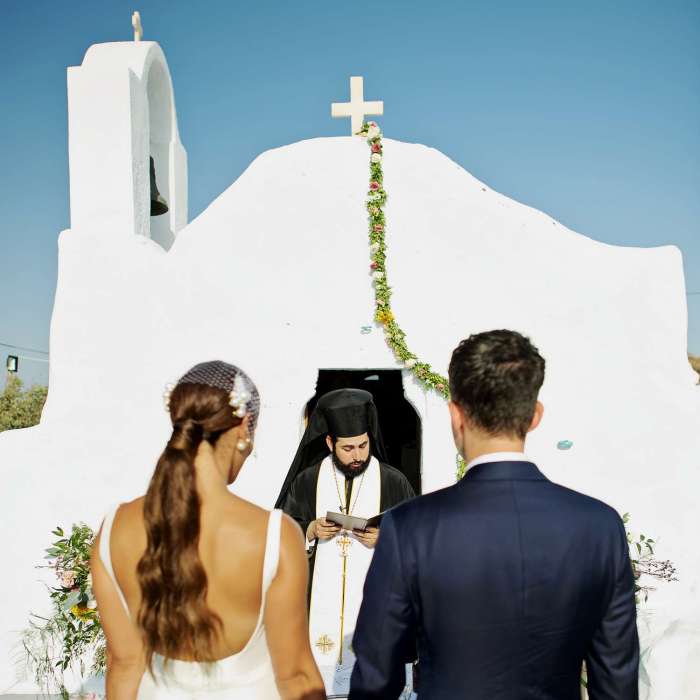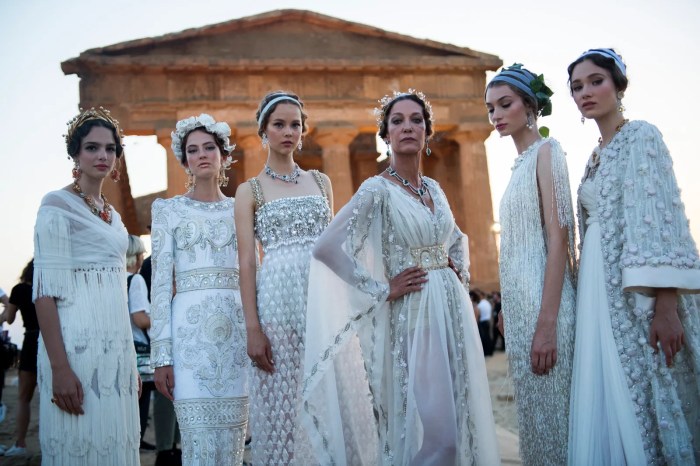Greek Wedding Dress Traditional A Timeless Elegance
A Timeless Elegance: The Evolution of the Greek Wedding Dress: Greek Wedding Dress Traditional
Greek wedding dress traditional – The Greek wedding dress, a symbol of tradition and beauty, boasts a rich history interwoven with mythology, cultural shifts, and evolving aesthetics. From the flowing chitons of antiquity to the modern interpretations that grace contemporary ceremonies, the dress reflects the enduring spirit of Hellenic culture. This exploration delves into the historical journey of this iconic garment, examining its regional variations, symbolic elements, and enduring appeal.
Historical Evolution of the Greek Wedding Dress
The evolution of the Greek wedding dress is a captivating narrative spanning millennia. Ancient Greek brides, depicted in pottery and sculpture, often wore simple, flowing chitons – long, draped garments typically made of linen or wool. These garments, often adorned with simple embroidery or woven patterns, reflected the simplicity and natural beauty valued in ancient society. The Classical period saw the introduction of more elaborate styles, including the stola, a longer, more structured garment sometimes worn over a chiton.
Influences from the Byzantine Empire introduced richer fabrics like silk and brocade, along with more intricate embroidery and embellishments. The Ottoman period brought about new silhouettes and details, with influences evident in the use of richer colors and more ornate designs. The 19th and 20th centuries saw the incorporation of Western styles, leading to the modern Greek wedding dress, which often blends traditional elements with contemporary designs.
Notable figures like Empress Theodora, known for her lavish attire, influenced the evolution of bridal fashion during the Byzantine era. Her wedding attire, likely featuring rich silks and elaborate jewelry, exemplifies the opulence of the period. While specific details of attire for many historical figures remain elusive, the available evidence paints a picture of gradual stylistic evolution influenced by societal changes and cross-cultural exchange.
Timeline:
- Ancient Greece (pre-500 BC): Simple chitons, linen or wool, minimal adornment.
- Classical Greece (500-323 BC): Introduction of the stola, more structured garment.
- Byzantine Period (330-1453 AD): Richer fabrics (silk, brocade), intricate embroidery.
- Ottoman Influence (1453-1821): Incorporation of Ottoman design elements, richer colors.
- 19th & 20th Centuries: Blending of traditional and Western styles, emergence of modern interpretations.
Regional Variations in Traditional Greek Wedding Dresses
The Greek wedding dress showcases fascinating regional diversity, reflecting the unique cultural nuances across the country. These variations extend beyond simple stylistic choices, carrying profound symbolic meanings deeply rooted in local traditions and beliefs.
| Region | Key Features | Symbolism | Notable Examples |
|---|---|---|---|
| Crete | Elaborate embroidery, darker colors, often incorporating local motifs. | Rich heritage, connection to the land. | Designs featuring olive branches and Cretan labyrinth patterns. |
| Macedonia | Simpler styles, often featuring rich fabrics and muted colors. | Emphasis on family and tradition. | Dresses incorporating traditional Macedonian embroidery styles. |
| Peloponnese | More ornate designs, often incorporating lace and embellishments. | Celebration of beauty and prosperity. | Dresses showcasing intricate hand-stitched lacework. |
| Islands (e.g., Mykonos, Santorini) | Lighter fabrics, brighter colors, often featuring flowing silhouettes. | Connection to the sea, lightheartedness. | Dresses incorporating blue and white motifs, reminiscent of the Aegean Sea. |
Fabrics and Embroidery Techniques

Source: brides.com
The choice of fabrics and embroidery techniques in traditional Greek wedding dresses holds significant cultural weight. These elements not only enhance the aesthetic appeal but also convey symbolic meanings related to prosperity, fertility, and the bride’s future.
Traditional fabrics include luxurious silks, heavy brocades, and fine linens. The embroidery, often painstakingly handcrafted, features intricate patterns and motifs, each carrying symbolic significance. Common motifs include olive branches (peace and prosperity), pomegranates (fertility), and stylized floral designs.
Example Embroidery Pattern: Imagine a repeating pattern of intertwined olive branches, their leaves rendered in deep green silk thread, punctuated by clusters of pomegranates embroidered in rich crimson. The olive branches symbolize peace and abundance, while the pomegranates represent fertility and the promise of a bountiful future. The interweaving design speaks to the interconnectedness of life and the enduring strength of the marital bond.
Symbolic Elements and Meanings, Greek wedding dress traditional

Source: co.uk
Traditional Greek wedding dresses are replete with symbolic elements, each carrying a deep cultural and religious meaning. These symbols transcend mere decoration, acting as powerful expressions of hope, faith, and the enduring spirit of the union.
The color white, for instance, signifies purity and new beginnings. Elaborate embroidery often incorporates motifs representing fertility, prosperity, and the couple’s shared journey. Regional variations in symbolism exist, with some regions emphasizing certain motifs over others. Modern interpretations often subtly incorporate these symbolic elements, maintaining a connection to tradition while embracing contemporary aesthetics.
The Modern Greek Wedding Dress: Tradition and Innovation
Contemporary Greek wedding dresses beautifully blend tradition and innovation, showcasing the enduring appeal of classic elements within a modern context. This fusion reflects the dynamic nature of Hellenic culture, which seamlessly integrates heritage with contemporary trends.
Traditional Greek wedding dresses often feature intricate embroidery and flowing silhouettes, embodying a timeless elegance. For a modern twist on this classic style, consider incorporating shimmering details, perhaps even opting for a breathtaking gold sparkly wedding dress to capture the light with every graceful movement. Ultimately, the perfect dress reflects the bride’s unique personality, whether it adheres strictly to tradition or boldly reimagines it.
- Traditional Dress: A flowing A-line silhouette, often in ivory silk or brocade, with intricate embroidery and traditional motifs.
- Modern Adaptation: A more fitted silhouette, perhaps with a modern neckline or sleeves, but still incorporating traditional embroidery or lace.
- Contemporary Interpretation: A minimalist design, using modern fabrics and silhouettes, but incorporating a subtle nod to tradition, such as a single embroidered motif or a specific color palette.
Accessories and Jewelry
Traditional accessories and jewelry complete the ensemble of a Greek bride, adding layers of symbolic meaning and visual impact to the overall look. These elements enhance the aesthetic appeal and serve as powerful reminders of cultural heritage and tradition.
A bride might wear a delicate gold necklace, symbolizing her new status and the preciousness of the union. A floral crown or a jeweled headpiece, often adorned with white flowers, could be included, adding a touch of elegance. A long, flowing veil, often made of lace or silk, symbolizes modesty and purity. The overall effect is one of understated elegance and timeless beauty, a testament to the enduring power of Hellenic aesthetics.
Imagine a bride adorned in a flowing white gown, her hair crowned with a delicate wreath of orange blossoms, their sweet fragrance mingling with the scent of the sea. A simple gold necklace rests against her skin, its subtle gleam catching the sunlight. A long, flowing veil trails behind her, creating an ethereal aura as she walks down the aisle, a vision of radiant beauty and enduring tradition.
The Wedding Ceremony and the Dress’s Role
The Greek wedding dress plays a central role in the ceremony itself, embodying the significance of the occasion and serving as a visual representation of the bride’s transition into marriage. The attire is not merely decorative; it is integral to the cultural and religious context of the event.
A traditional Greek Orthodox wedding ceremony unfolds in stages, each marked by specific rituals and symbolic actions. The bride’s attire remains consistent throughout, symbolizing her commitment and the sacredness of the vows. The dress’s elegance and symbolism serve as a powerful visual representation of the couple’s journey into married life.
- The Entrance: The bride enters the church, her dress a radiant symbol of purity and hope.
- The Vows: As she exchanges vows with her groom, her dress serves as a silent witness to their commitment.
- The Crowning: During the crowning ceremony, a pivotal moment in the service, the bride’s dress reflects the sacredness of the union.
- The Reception: As the celebration begins, the dress remains a symbol of the couple’s joy and shared future.
User Queries
What is the average cost of a traditional Greek wedding dress?
The cost varies greatly depending on the fabrics, embellishments, and designer. Expect a range from several hundred to several thousand dollars.
Can I rent a traditional Greek wedding dress?
Yes, many bridal shops specialize in renting traditional or inspired gowns. This can be a more affordable option.
Where can I find a seamstress specializing in Greek wedding dresses?
Check online directories, bridal forums, and local Greek communities for recommendations. Many experienced seamstresses specialize in this type of intricate work.
What are some modern twists on the traditional Greek wedding dress?
Modern adaptations often incorporate sleek silhouettes, updated embroidery techniques, and the addition of modern fabrics while retaining key traditional elements like the embroidery style or color palette.



















